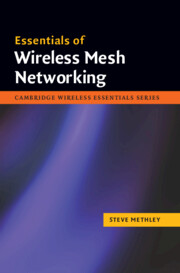Book contents
- Frontmatter
- Contents
- Preface
- Acknowledgements
- 1 Mesh overview and terminology
- 2 Attractive mesh attributes and applications
- 3 Fundamentals of mesh technology
- 4 Mesh capacity, scalability and efficiency – hypothesis testing
- 5 Mesh susceptibility
- 6 Mesh services and quality of service
- 7 Summary of potential mesh pitfalls to avoid
- 8 Appropriate telecommunications applications for mesh
- 9 Successful mesh implementations
- 10 Wireless sensor networks (WSNs) as mesh networks
- Abbreviations
- Selected definitions
- Appendix: Mobility models
- About the author
- Index
- Mesh hints and tips
10 - Wireless sensor networks (WSNs) as mesh networks
Published online by Cambridge University Press: 01 March 2010
- Frontmatter
- Contents
- Preface
- Acknowledgements
- 1 Mesh overview and terminology
- 2 Attractive mesh attributes and applications
- 3 Fundamentals of mesh technology
- 4 Mesh capacity, scalability and efficiency – hypothesis testing
- 5 Mesh susceptibility
- 6 Mesh services and quality of service
- 7 Summary of potential mesh pitfalls to avoid
- 8 Appropriate telecommunications applications for mesh
- 9 Successful mesh implementations
- 10 Wireless sensor networks (WSNs) as mesh networks
- Abbreviations
- Selected definitions
- Appendix: Mobility models
- About the author
- Index
- Mesh hints and tips
Summary
This book has so far focused on meshes for telecommunications, however another use of multi-hop networking is the wireless sensor network. In fact it is potentially beginning to look like WSNs might outstrip telecommunications as a use for multi-hop and mesh technology. We have kept this chapter separate as WSNs have some unique properties, but we find that many aspects of mesh discussed earlier in the book apply to WSNs in much the same ways. In terms of applications, at the time of writing, smart buildings (advanced control of lighting and HVAC, heating ventilation and air-conditioning) and logistics look like the top two likely WSN applications, in terms of earliest uptake.
Let us begin with an introduction to wireless sensor networks. We take quite a broad overview before concentrating on the networking aspects of WSNs.
The role of a wireless sensor network is essentially that of a monitor. Broadly speaking, what is being monitored can usually be placed within one of three groups:
area monitoring – i.e. monitoring somewhere; examples include the environment or area alarms (intrusion etc.);
entity monitoring – i.e. monitoring something; examples include a civil structure (bridge, building etc.) or a human body;
area–entity interaction monitoring – i.e. monitoring something, somewhere, in context; examples include vehicles on the road, asset tracking or the flow of a manufacturing process.
As to why a sensor network is important, it is most simply understood by realising that, often, individual sensors themselves are limited in their ability to monitor a given situation.
- Type
- Chapter
- Information
- Essentials of Wireless Mesh Networking , pp. 180 - 214Publisher: Cambridge University PressPrint publication year: 2009



